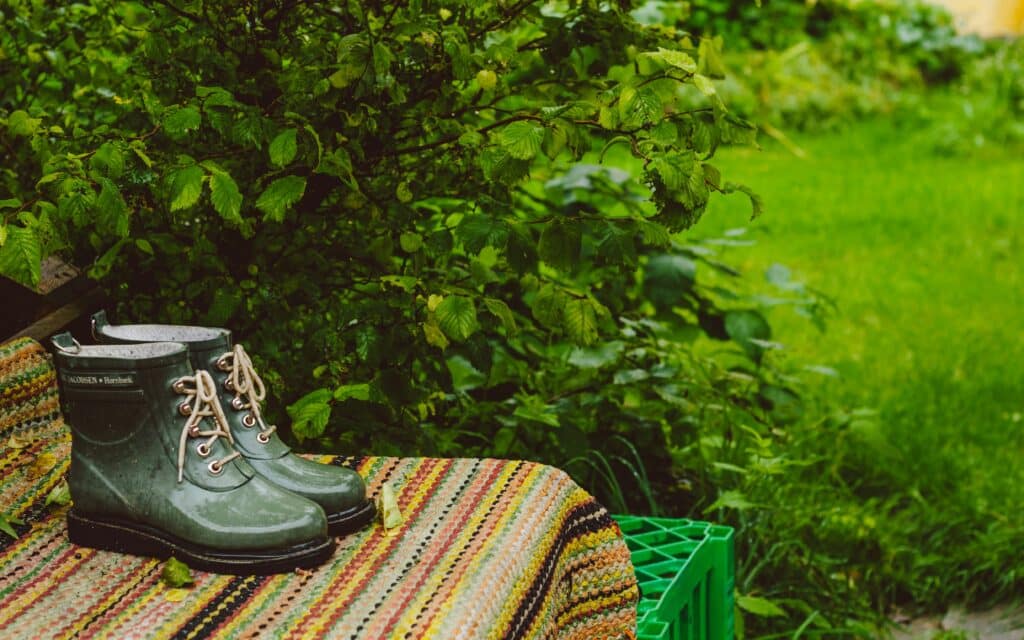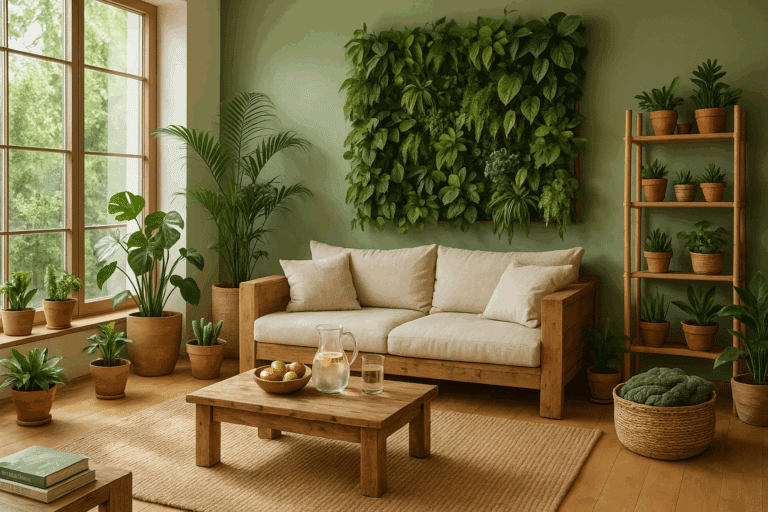Step right in as we delve deep into the world of natural fiber garden rugs, an eco-friendly ground cover that takes your patio aesthetic to new heights. Unravel the art of creating serene, inviting spaces with environmentally friendly materials, enhancing your patio while minimizing your carbon footprint.

Discover the unmatched allure of garden rugs crafted from natural fibers like jute, sisal, and seagrass. As we journey through the rich textures, diverse patterns, and versatile designs these rugs offer, you’ll see how they can transform your outdoor spaces. These rugs not only elevate your patio with their aesthetic appeal but also make a powerful statement about your commitment to sustainability.
So, buckle up and prepare to infuse your outdoor décor with a new layer of sophistication and sustainability. By the end of this exploration, you’ll be brimming with inspiration to spruce up your patio with eco-friendly ground cover. Are you ready to elevate your outdoor living experience and step into sustainable style with natural fiber garden rugs? Let’s begin!
The Evolution Towards Natural Fiber Garden Rugs
In recent years, our collective consciousness has shifted dramatically towards sustainability and eco-responsibility. What was once considered niche—organic food, reusable bags, eco-friendly cleaning products—has now become a core part of mainstream consumer behavior. As a result, sustainability has transcended indoor living and is now influencing the way we design and decorate our outdoor spaces. One of the most innovative and stylish reflections of this trend is the rise of natural fiber garden rugs—a perfect union of ecological awareness and outdoor elegance.
These rugs, made from biodegradable materials such as jute, sisal, coir, hemp, and seagrass, are becoming must-haves for homeowners and interior designers alike. Whether used on patios, decks, balconies, or garden pathways, natural fiber rugs offer a blend of functionality, style, and sustainability that synthetic alternatives simply cannot replicate. In this comprehensive guide, we explore the materials, manufacturing processes, environmental impact, aesthetic value, and long-term benefits of choosing natural fiber rugs for your garden.
A Cultural Shift Towards Sustainable Outdoor Living
The concept of outdoor living spaces has evolved significantly. No longer just a space for a barbecue or a few chairs, patios and gardens have transformed into full-scale lifestyle extensions of the home. People are investing in high-quality furniture, lighting, shade solutions, and yes—flooring, including rugs—to make the outdoors as comfortable and stylish as the indoors.
Within this evolution, there has also been a notable ethical awakening. Homeowners and designers are increasingly asking: Is this product environmentally responsible? What materials is it made from? How will it affect the planet once I’m done using it?
This ethical inquiry has led to the growing popularity of natural fiber garden rugs, which are sustainable, biodegradable, and beautifully suited to open-air environments.
What Are Natural Fiber Garden Rugs?
Natural fiber garden rugs are floor coverings made from renewable plant-based materials. Unlike synthetic rugs, which are often made from petroleum-based products like polypropylene, these rugs rely on fibers that grow from the earth, return to it without polluting, and support eco-conscious agricultural practices.
Common Natural Fibers Used:
- Jute – Soft, affordable, and beautifully textured, jute rugs are ideal for semi-covered outdoor spaces like screened porches.
- Sisal – Known for its durability and resistance to wear, sisal is perfect for high-traffic outdoor zones.
- Seagrass – Naturally resistant to moisture and stains, seagrass is a top choice for humid environments or areas prone to rain.
- Coir – Derived from coconut husks, coir is rougher in texture but incredibly resilient to wear and moisture.
- Hemp – Strong and mildew-resistant, hemp rugs work well in both indoor and outdoor areas.
- Abaca – A luxurious yet sturdy fiber derived from banana leaves, abaca rugs are ideal for shaded patios.
These fibers are spun into yarns, woven into rugs, and finished using minimal chemical treatments—making them as safe for the environment as they are attractive.
Environmental Impact of Synthetic Rugs
Before diving deeper into the benefits of natural fiber rugs, it’s crucial to understand the ecological cost of synthetic alternatives. Traditional outdoor rugs are often made from synthetic materials like polypropylene, nylon, or polyester. These substances are derived from fossil fuels, require energy-intensive manufacturing, and contribute to long-term environmental harm.
Key Concerns:
- Non-biodegradability: Synthetic rugs can take hundreds of years to decompose in landfills.
- Microplastic Pollution: As synthetic rugs wear down, they shed microfibers that often end up in waterways, harming marine life.
- Carbon Footprint: The production and transportation of synthetic materials consume large quantities of energy and release greenhouse gases.
- Toxicity: Many synthetic rugs are treated with flame retardants, dyes, and chemical finishes that can be harmful to indoor air quality and soil health.
By contrast, natural fiber rugs decompose cleanly, often without leaving behind toxic residues or pollutants, aligning perfectly with principles of zero waste and circular economies.
The Many Benefits of Natural Fiber Garden Rugs
Choosing natural fiber garden rugs goes far beyond making a statement about sustainability—it also yields practical, aesthetic, and economic benefits.
1. Durability and Longevity
Natural fibers such as sisal, coir, and seagrass are known for their toughness. These rugs can withstand harsh weather conditions, high foot traffic, and exposure to natural elements. While they might not be completely waterproof, they resist mildew better than many synthetic alternatives when cared for correctly.
- Sisal and coir are particularly good at holding their structure under foot traffic.
- Seagrass is non-porous and naturally stain-resistant, ideal for poolside or coastal climates.
2. Comfort and Tactility
Unlike plastic rugs, natural fiber rugs offer a pleasant tactile experience. Jute and hemp, for example, are softer underfoot, making them great for barefoot lounging on the patio.
These rugs also regulate temperature naturally—cool under summer sun and insulating in the cooler months—adding to the year-round comfort of your outdoor space.
3. Style and Visual Appeal
Natural fiber rugs bring texture, warmth, and earth tones into your patio, helping you create a cozy and inviting atmosphere. Their woven patterns, raw aesthetic, and organic colors allow for seamless integration with wood, stone, and greenery, all while exuding a sense of artisanal charm.
From rustic cottage gardens to modern urban balconies, they can enhance any outdoor design scheme.
4. Non-Toxic and Family Safe
For homes with children or pets, natural fiber rugs offer an important benefit: safety. Free from synthetic dyes and harsh flame-retardant chemicals, these rugs minimize toxic exposure and contribute to healthier air quality.
How to Choose the Right Natural Fiber Rug for Your Outdoor Space
Selecting the perfect rug for your garden or patio is both an art and a science. Here are the top considerations:
1. Assess the Climate
- In humid areas, choose moisture-resistant options like seagrass or coir.
- In dry climates, jute and hemp perform exceptionally well.
- For sun-exposed patios, look for UV-resistant finishes or rotate your rug to avoid uneven fading.
2. Determine the Function
- For dining areas, select a flat-weave rug that’s easy to clean.
- For lounging areas, a softer weave like jute adds comfort.
- If you’re layering rugs for aesthetic effect, choose contrasting textures and tones for visual interest.
3. Measure the Space
Always measure your space carefully and leave a border around the rug to showcase your flooring or pavers. Use round rugs to soften angular layouts or rectangular rugs to define seating zones.
4. Check for Backing and Weave Type
Some natural rugs come with latex or cotton backings to help prevent slipping. Others are reversible, offering extended lifespan through occasional flipping.
Maintenance Tips for Natural Fiber Garden Rugs
While natural fiber rugs are relatively low-maintenance, a few simple steps can prolong their life and keep them looking fresh:
1. Shake and Vacuum Regularly
Outdoor areas can gather leaves, dust, and debris. Shake the rug out weekly and vacuum it gently to avoid embedding dirt between the fibers.
2. Blot Spills Immediately
Use a clean, dry cloth to blot up moisture. Avoid scrubbing, which can fray the natural fibers. For persistent stains, a mild soap and water mix can be applied sparingly.
3. Rotate for Even Wear
Sunlight and foot traffic can cause uneven fading or wear. Rotate your rug every few months to distribute exposure.
4. Elevate from Ground During Rainy Seasons
To avoid mold or fiber breakdown, consider lifting the rug or using a breathable rug pad during heavy rain. Dry completely before placing it back.
Elevating Outdoor Aesthetics
Natural fiber garden rugs are more than functional floor coverings—they are design centerpieces. Here’s how to integrate them beautifully:
- Layer with Textiles: Pair with throw pillows, cushions, and blankets in complementary hues.
- Coordinate with Furniture: Choose wood, rattan, or metal furniture that echoes the natural vibe of your rug.
- Frame a Feature: Use the rug to draw attention to a centerpiece, such as a firepit, water fountain, or sculpture.
- Seasonal Swaps: Swap out lightweight rugs in spring/summer and thicker weaves in fall/winter to reflect seasonal textures.
Why Natural Fiber Rugs Reflect Conscious Living
Choosing a natural fiber rug isn’t just a design decision—it’s a lifestyle affirmation. It reflects a belief in mindful consumption, ethical production, and aesthetic sustainability. Each rug you buy supports:
- Local artisan economies
- Agricultural ecosystems
- Low-emission supply chains
- A cleaner planet for future generations
Your garden becomes not just a personal sanctuary but also a testament to environmental stewardship.
Bringing Nature Beneath Your Feet
The evolution of outdoor spaces—from functional zones to holistic living areas—has ushered in a new era of mindful design. Natural fiber garden rugs exemplify this evolution. They are stylish yet simple, durable yet biodegradable, and elegant yet ethical.
Whether you’re creating a tranquil meditation nook, a lively family gathering spot, or a romantic alfresco dining area, a natural fiber rug is a grounding element—literally and figuratively. It unites the organic with the intentional and elevates your patio from a space you use to a space you cherish.

So next time you’re planning an outdoor refresh, remember: a rug doesn’t just tie the room together. In the case of natural fiber rugs, it ties your home to the earth.
Conclusion
In conclusion, stepping into sustainable style with natural fiber garden rugs truly elevates your patio aesthetics while contributing to eco-friendly initiatives. These rugs are a testament that functionality, style, and environmental consciousness can co-exist. Made from renewable resources like sisal, jute, and seagrass, these ground covers are both biodegradable and recyclable, making them a smart choice for the environmentally aware consumer.
Moreover, these rugs add a touch of nature to your outdoor living spaces, creating a comfortable, inviting atmosphere. They not only serve as a visual treat but also provide practical benefits like durability, ease of maintenance, and adaptability to various weather conditions. The charm of these rugs is in their uniqueness – no two rugs are the same, just like no two fibers in nature are identical. This individuality adds authenticity and character to every outdoor setting, turning your patio into a space that reflects both personal style and a commitment to the planet.
These rugs can effortlessly blend with a variety of outdoor themes—from minimalist and modern to rustic and bohemian—making them incredibly versatile. Whether you’re decorating a city balcony or a countryside veranda, natural fiber rugs adapt beautifully to the space. Their earthy textures and neutral tones harmonize with greenery, wood, stone, and other organic elements commonly found in garden settings.
So, for those looking to revamp their patio or garden space, consider natural fiber rugs as an eco-friendly ground cover. You will not only embrace a sustainable lifestyle but also create a stylish and comfortable outdoor oasis. Let your outdoor decor choices reflect your values and inspire others to think sustainably as well.
Let’s step into sustainability with style, one natural fiber rug at a time.
Remember, every eco-friendly choice we make today contributes to a healthier, greener planet for future generations. So, let’s choose wisely and let our choices reflect our commitment to sustainability. Natural fiber garden rugs are indeed a step in the right direction—where form meets function, and style meets stewardship. So, let’s walk the talk and make sustainability a way of life—starting right from under our feet. 🌿🪴🌞



